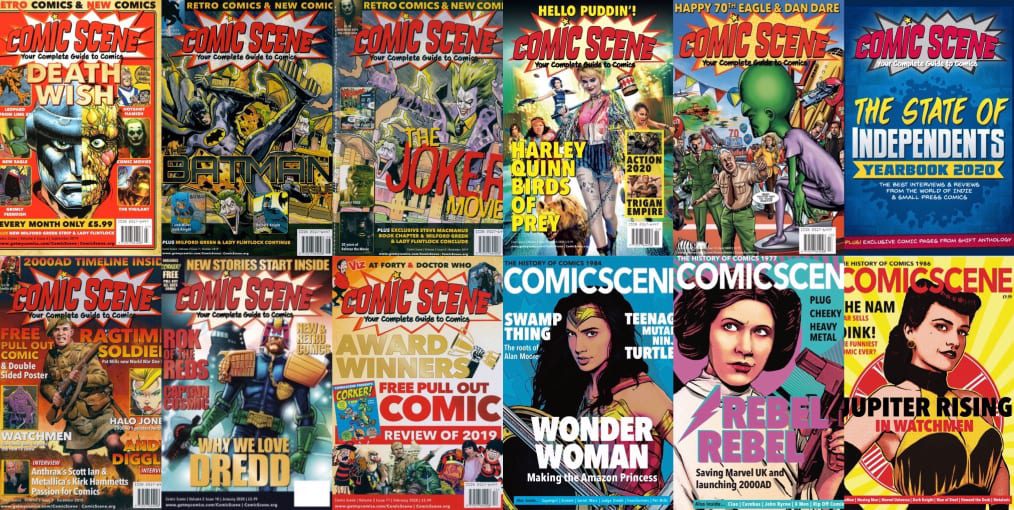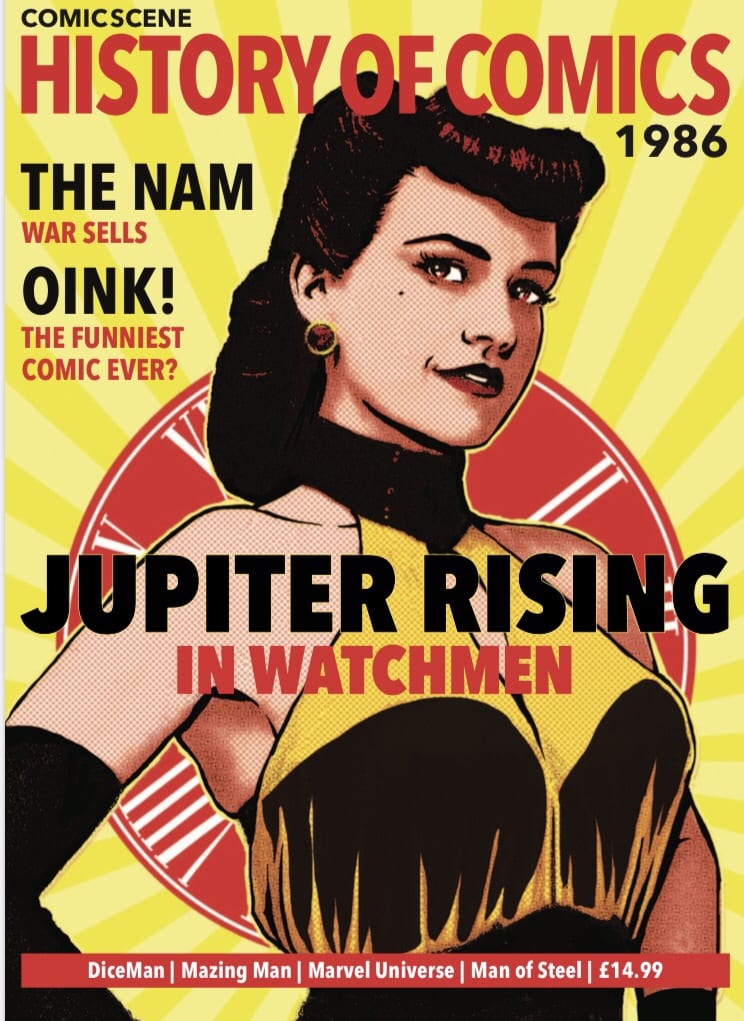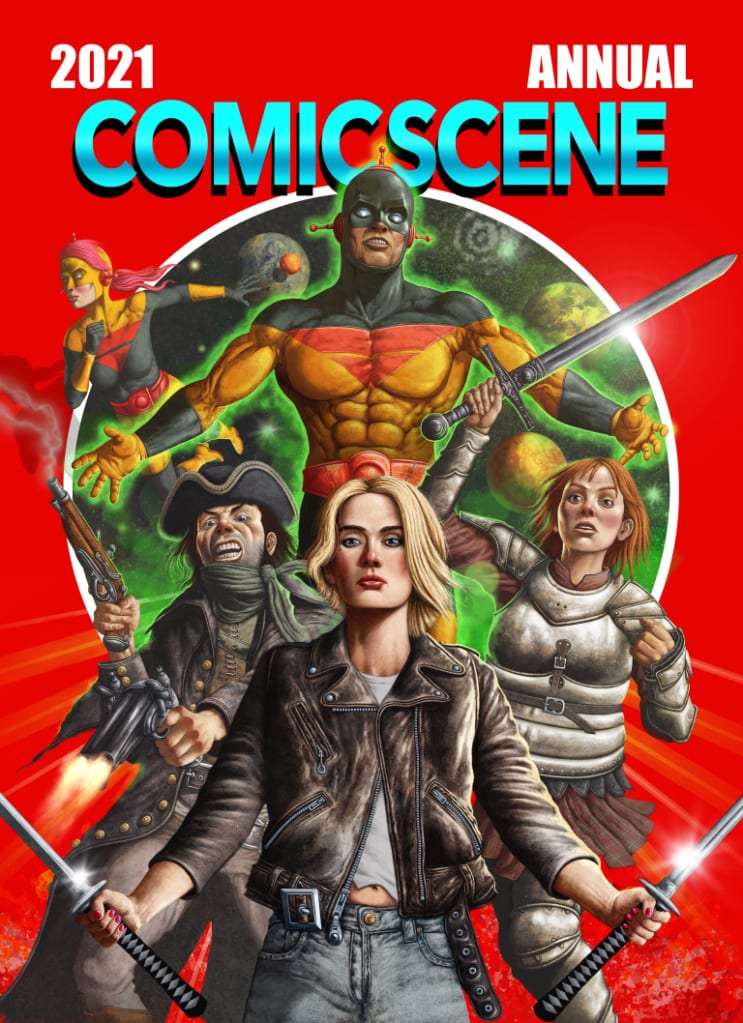If you are a comic fan in the UK you may have heard of Comic Scene, a very British magazine dedicated to comics and (mainly) the British comic industry. The magazine included everything you would expect from such a publication, with reviews, articles, and comic strips. Despite a successful year in 2019, which saw the magazine hit the newsstands across the country, a new project by the publisher somewhat overshadowed the monthly publication and shifted the focus for the future.
Comic Scene History of Comics is an ambitious project that intends to chart a century of comics, with each book focusing on a single year. The first set of four books were launched on Kickstarter in 2020 and easily reached their required project goal. Digital and physical copies are available, in sets or individually. Basically, however you want to consume it, they’ve got you covered.

Content and Coverage
Deciding not to release the books in a chronological order, the first four releases cover the years 1950, 1977, 1984, and 1986. These years have some monumental pop culture releases, the Watchmen comic and the Star Wars movie for example, and allows the magazine to come out of the gate running. The covers, featuring Pop Art renditions of Princess Leia and Silk Spectre, leap off the page to entice readers. In fact, all four of the covers feature powerful and complex female comic book characters, which makes a strong statement about the magazine and establishes the inclusivity of the project.
MFR ON YOUTUBE (latest video)
Help us reach 5K Subs!
The contents, overseen by managing editor Tony Foster, are a mixture in every sense. They cover a wide range of comics and related culture, from the classic Superhero floppies to comic strips such as Peanuts. Featured articles cover the history of characters, creators, and even publishers, while the rest of the pages are filled with reviews, general historical facts, and a gallery of images relating to the specific year. This means that you will find yourself entirely engrossed in some sections while flipping quickly past others. However, there is more than enough content in each issue to keep most readers satisfied.
Each issue opens with a Culture and Comics section written by John McShane. These articles superbly set the scene for the magazine by capturing the dedicated year in terms of Comics and the society surrounding them. They include hints to features coming up while painting a comics-centric landscape for all of the other elements of the magazine to grow in.
And there are some gems included among the articles. In the 1984 issue there is a fascinating interview with Ian Gibson about his work on Halo Jones for 2000AD. Bob Bailey shines a light on the Silver Age versions of Lana Lang and Lois Lane in the 1950 issue, which also includes some shorter articles on the Eagle and Dan Dare. 2000AD is picked up again by Chris Hallam in the 1977 issue but is overshadowed by Mark Newbold’s look at the rise of the Star Wars publications.

Cover Design: Flops Comics
Considerations and Comic Strips
There is a very nostalgic feel to a lot of the writing, with the authors sharing personal memories along with established facts. Articles covering some of the lesser known comics and characters prove to be the most interesting reads. While pieces on more popular works, like Chris Hallam’s article on Watchmen, don’t tend to have anything new to say. In fact, the Watchmen article barely has anything to say about the comic at all and is more interested in the cultural influence and adaptations that came out of it. One of the few drawbacks to the History of Comics is the inconsistencies with some of the articles included. The 1986 issue should have featured a much more in depth look at Watchmen because of its significance to the comic book industry and the article that is included ends up being a disappointment by default.
Another example of the inconsistencies comes in the 1950 issue which features an article on the Senate Subcommittee Hearings on juvenile delinquency. Written by Christoper Irving, the article itself is insightful and well researched, however it covers an incident in comics history from 1954 and would surely fit better into the volume dealing with that year. 1950 saw the release of a number of first issues from EC Comics that have become world famous. With comics like Crime Suspend Stories, The Haunt of Fear, and Two-Fisted Tales making their debut, a feature covering the releases of these comics would have been more fitting than drawing attention to their ending.
The History of Comics project isn’t all that the Comic Scene team are up to. They also have a commitment to producing new comic anthologies using some amazing creators. Just like the magazine, the comic strips are a mix of styles and genres and have a fairly wide appeal. If you have grown up on the likes of 2000AD then the Comic Scene Annual will be worth checking out.

Conclusion
There is no denying that the world of Comics is expanding. The movie industry is awash with characters from the pages of comic books, television is adapting and expanding comic narratives, and the internet is becoming a new medium to engage and consume comics. Into this mix a magazine like History of Comics is a welcome addition, feeding on the nostalgia of long time readers but also acting as an introduction for a new generation into the world of comic books. With appealing covers, a curated mix of articles and reviews, and plenty of images to break up the text, History of Comics is definitely making a lot of the right moves.
The first four issues have a few teething problems, with a little more care required to some of the article’s inclusions, but on the whole they are satisfying reads. Personally I could live without the pages of Comic Facts, most of which are elaborated on earlier in the issues, and the Comic Museum could use some work to make it more appealing. However, these aspects will appeal to some of the readers and the diversity in features is one of the magazine’s strong points.
History of Comics is an ambitious project and has got off to a great start. If you have an interest in how the modern comic industry was formed and how certain characters became Icons, then this magazine is for you. Not every page will be of interest but the majority of it will be. Even if you only have a passing interest in comic book history, there will be an issue that appeals to you and in a format that suits your reading habits.
Check out the website (comicscene.org) for news and updates on the project and to get your hands on a copy of one, or more, of the magazines.

